
ロードライトガーネットの宝石:特性、意味、価格ガイド
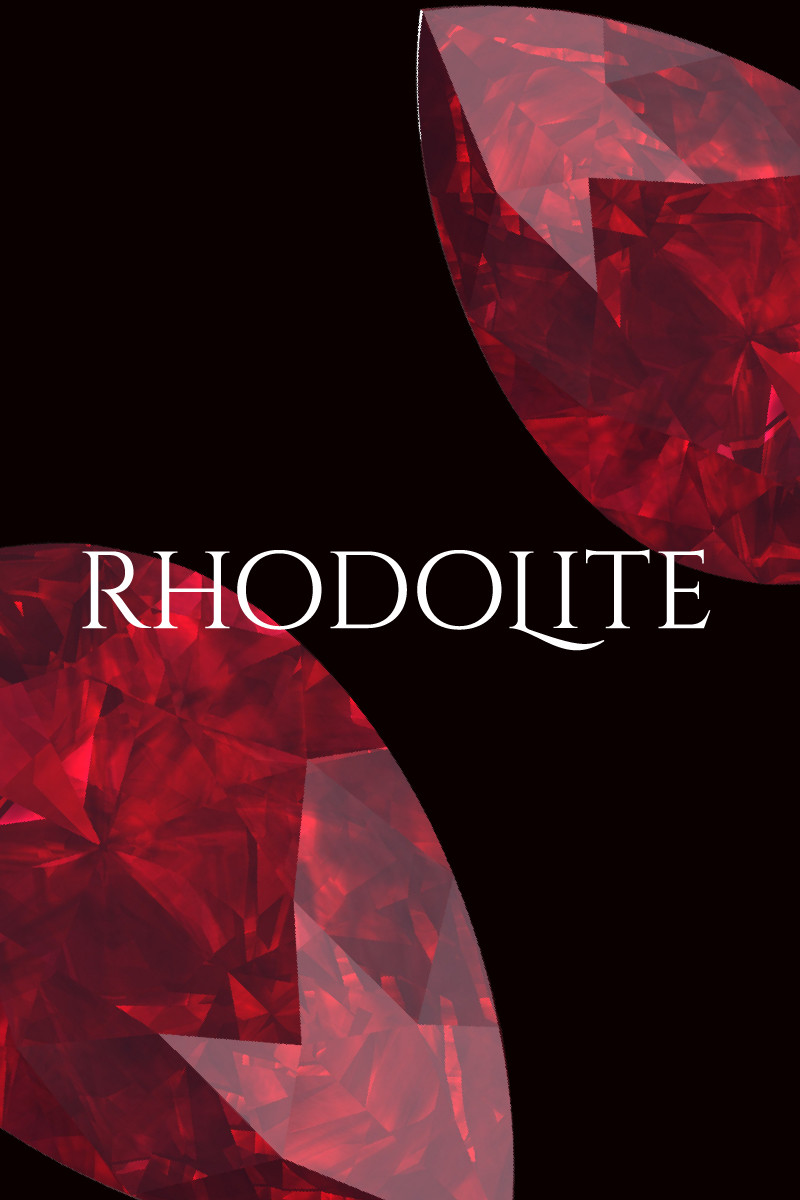 ロードライトは、ピンクから赤紫色のガーネット宝石の一種です。ロードライトガーネットは天然石ですか?もちろんです!ラズベリー、プラム、ワインなど、ロードライトの美しい色合いはすべて自然が作り出したものです。
ロードライトは、ピンクから赤紫色のガーネット宝石の一種です。ロードライトガーネットは天然石ですか?もちろんです!ラズベリー、プラム、ワインなど、ロードライトの美しい色合いはすべて自然が作り出したものです。
ガーネットの中でも、ロードライトはより淡く紫がかった色と、産地の多様性で際立っています。宝石全般の中でも、ロードライトは高い屈折率(素晴らしい輝き)と、豊かでロマンチックな色合いで際立っています。
しかし、ロードライトガーネットは本当に良い石なのでしょうか?私たちはそう思いますが、このガイドを読み終える頃には、あなた自身でもそう思うようになるでしょう。
今日は、ロードライトガーネットの特性、治癒力、歴史、価格などについて詳しく説明します。
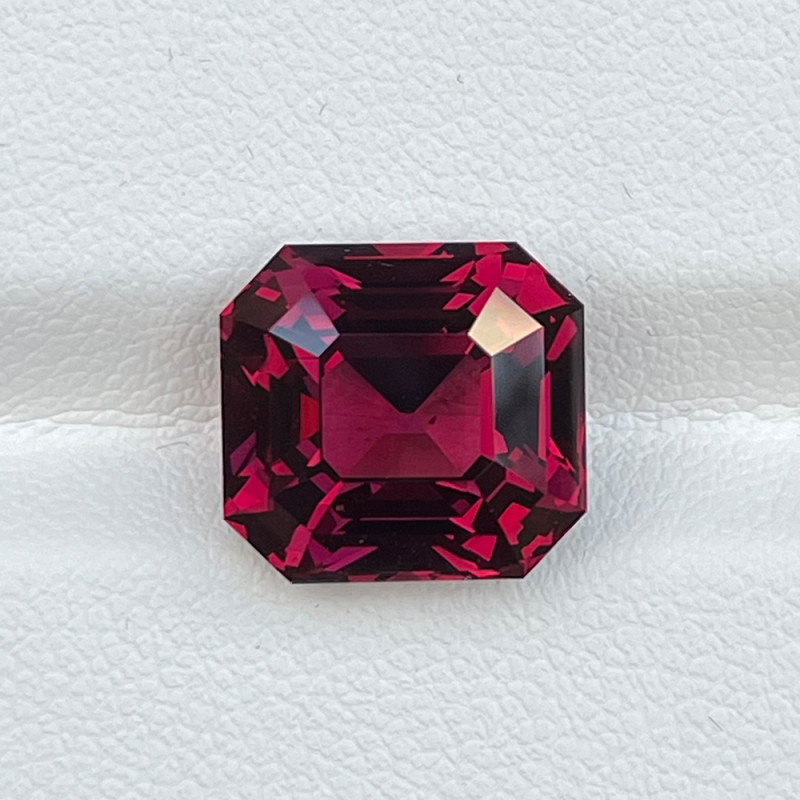
ロードライトガーネットについて
ロードライトガーネットは半貴石ですが、宝石であるルビーによく似ています。ロードライトには以下のような愛称があります。
アリゾナ・ルビー
モンタナ・ルビー
ニューメキシコルビー
もちろん、ロードライトとルビーは異なる石です。
ロードライトガーネットとルビーの主な違いは、組成、硬度、価格、そして希少性です。ルビーはコランダム系の宝石で、 モース硬度スケールではロードライトよりも硬度9です。また、ルビーはロードライトよりも希少で高価です。
ロードライトは比較的安価なので、伝統的な7月の誕生石であるルビーの手頃な代替品として最適です。ロードライトは、他のガーネットと同様に、 1月の誕生石、山羊座または水瓶座、 星座石、そして2回目の結婚記念日の宝石でもあります。
よくある混同として、ロードライトはロードナイトとよく混同されます。ロードナイトは不透明なバラ色のマンガンイノケイ酸塩宝石で、黒から茶色の縞模様や斑点が見られることが多いです。
 上の写真:ファセット加工されたレッドロードライトガーネットのイヤリング
上の写真:ファセット加工されたレッドロードライトガーネットのイヤリング
ロードライトの仕様と特徴
ガーネット鉱物グループは複雑な系譜を持っています。主な系列は、パイラルスパイト(パイロープ、アルマンディン、スペサルタイト)とウグランダイト(ウバロバイト、グロッシュラー、アンドラダイト)です。それぞれの種には独自の変種がありますが、多くの変種は交雑種です。
ロードライトはパイロープとアルマンディンの交配種で、「ピランディン」という愛称で呼ばれています。この石の化学式は(Fe,Mg)3Al2Si3O12です。
伝統的に、ロードライトはアルマンディン1に対してパイロープ2の割合で含まれると考えられていました。現代の宝石学の文献では、その割合はアルマンディン3に対してパイロープ7とされています。
しかしながら、スペサルタイトやグロッシュラーのような他の種の痕跡はロードライトによく見られ、パイロープとアルマンディンの比率はロードライトごとに異なる可能性があります。
ロードライト ガーネットは強い磁性から非常に強い磁性を持つため、磁石を使えばロードライトと似た外観の宝石を区別できるかもしれません。
ロードライトのその他の特性は次のとおりです。
モース硬度:7~7.5
色: ラベンダーピンク、ラズベリー、赤、紫がかった紫、赤紫、赤紫、紫、赤など、ピンク、赤、紫の間の明るい色合いから暗い色合い
結晶構造:立方晶系/等軸晶系
光沢:ガラス質
透明性:半透明から透明
屈折率:1.745~1.795(出典によって範囲が異なります。タンザニア = 1.745~1.760、米国ノースカロライナ州 = 1.760~1.761、ジンバブエ = 1.750~1.760)
密度: 3.74~3.94 (情報源によって範囲が異なります。タンザニア = 3.79~3.80、米国ノースカロライナ州 = 3.84~3.89、ジンバブエ = 3.83~3.89)
胸の谷間:なし;時々不明瞭な分け目
骨折:貝殻状
縞模様:白
発光:なし
多色性:なし
光学的効果:まれに星状現象、まれに色の変化
分散:0.026
ロードライト自体も変種ですが、いくつかのサブタイプも存在します。
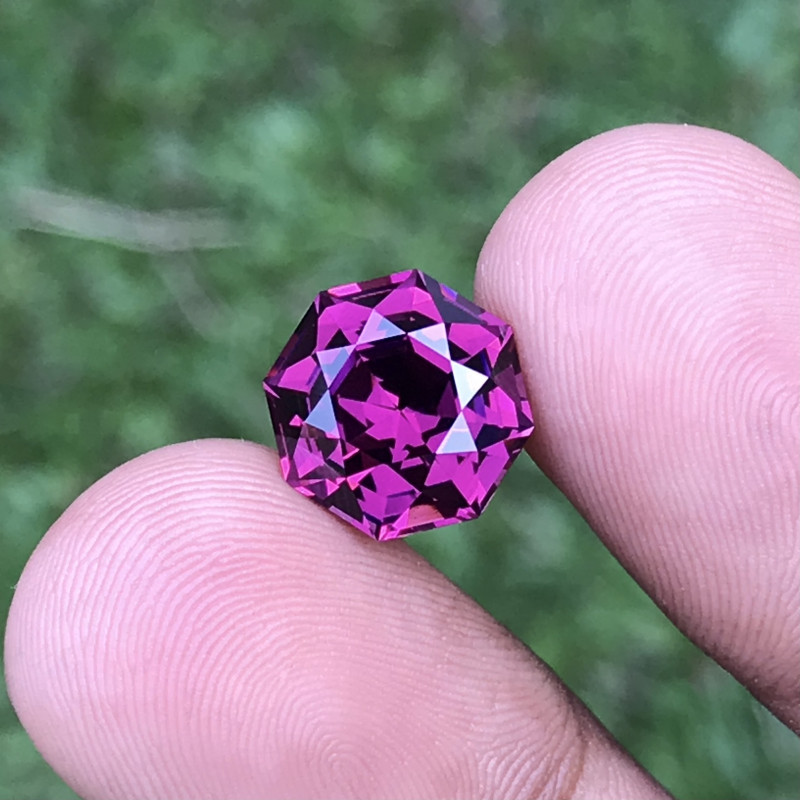 上の写真:グレープガーネット
上の写真:グレープガーネット
ロードライトの種類
最初のロードライトのサブタイプはグレープガーネットで、微量の鉄とマグネシウムによって濃い紫色をしています。
次はウンバライトガーネットです。
タンザニアのウンバ川渓谷産のウンバライトガーネットは、ピンクがかった赤、紫がかったピンク、または紫がかった赤を帯びたロードライトで、他のロードライトよりも鮮やかな色合いをしています。この高品質なサブタイプは「ロードライトの王様」と呼ばれることもあります。
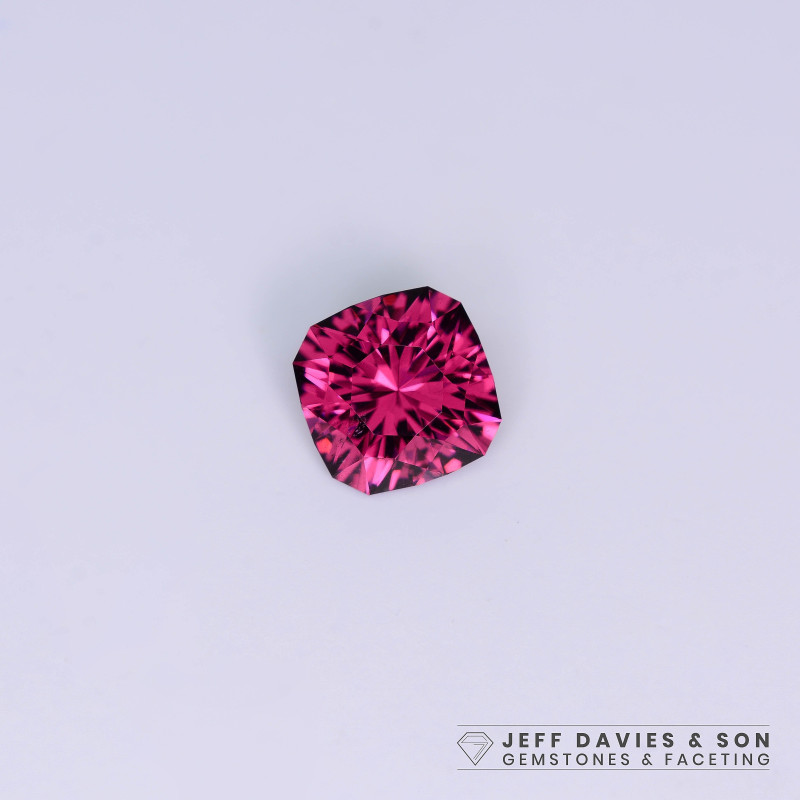 上の写真:ウンバライトガーネット
上の写真:ウンバライトガーネット
光学効果のサブタイプに移り、まずは色が変わるロードライトから始めましょう。
ロードライトを含む多くのガーネットは色が変わります。色が変わるロードライトは、日光の下では青く、白熱灯の下では赤紫に見えます。
最後に、スターロードライトガーネットです。
このサブタイプはアステリズム(光学的効果)を示します。これは、表面で光が複数の光線状に反射し、星型を形成する現象です。星型は4本または6本の光線を持つ場合があり、異なる角度から4本と6本の光線状反射が見られる標本もあります。ただし、ロードライトではアステリズムはまれです。
 上の写真:中国の龍に彫られたロードライトガーネット
上の写真:中国の龍に彫られたロードライトガーネット
ロードライトガーネットの意味と歴史
ロードライトは愛、共感、そして寛大さを象徴します。2周年記念の宝石として、このガーネットはカップルにとって消えることのない愛の炎を象徴します。
ガーネットは何世紀も前に遡る、古くから知られる宝石の一つであることをご存知かもしれません。その長い歴史により、ロードライトガーネットのスピリチュアルな意味には様々な解釈が生まれています。
歴史的に、ガーネットは光(精神的にも文字通りにも)、生命、そして保護を象徴していました。今日では、ロードライトも同様の意味を持ち、友情、献身、情熱を象徴しています。
歴史
ロードライトは比較的新しい発見です。アメリカの鉱物学者ウィリアム・アール・ヒデンは、1893年と1897年に地元の鉱物学者A.M.フィールドから報告を受け、米国ノースカロライナ州で発見された新しいガーネットについて初めて知りました。
フィールドは、これらの石がアルマンディンの変種であると信じていました。ヒデンと彼の同僚であるJ・H・プラット博士は、これらの石を分析し、1898年にその結果を発表しました。その中で「ロードライト」という名称を提案し、組成がパイロープとアルマンディンの混成物であることを確認しました。
ロードライトの名称は、ギリシャ語で「バラ」または「バラ色の」を意味するrhodonに由来すると考えられます。しかし、ロードライトに似た色のシャクナゲの花に由来する説もあります。
「ロードライト」という用語は正式な鉱物学上の名称ではないことに注意が必要です。これはパイロープ・アルマンディン・ガーネットのマーケティングでよく使われる通称です。
ロードライト変種の発見
1978年、タンザニアの鉱山労働者がウンバ川渓谷でウンバライトガーネットを初めて発見しました。
1988年にタンザニアのモロゴロ地方で発見された色の変わるガーネットは長年ロードライトだと考えられていたが、その後の分析で実際にはパイロープとスペサルタイトの混成石であることが証明された。
歴史から癒しに移りますが、ロードライトは何に良いのでしょうか?
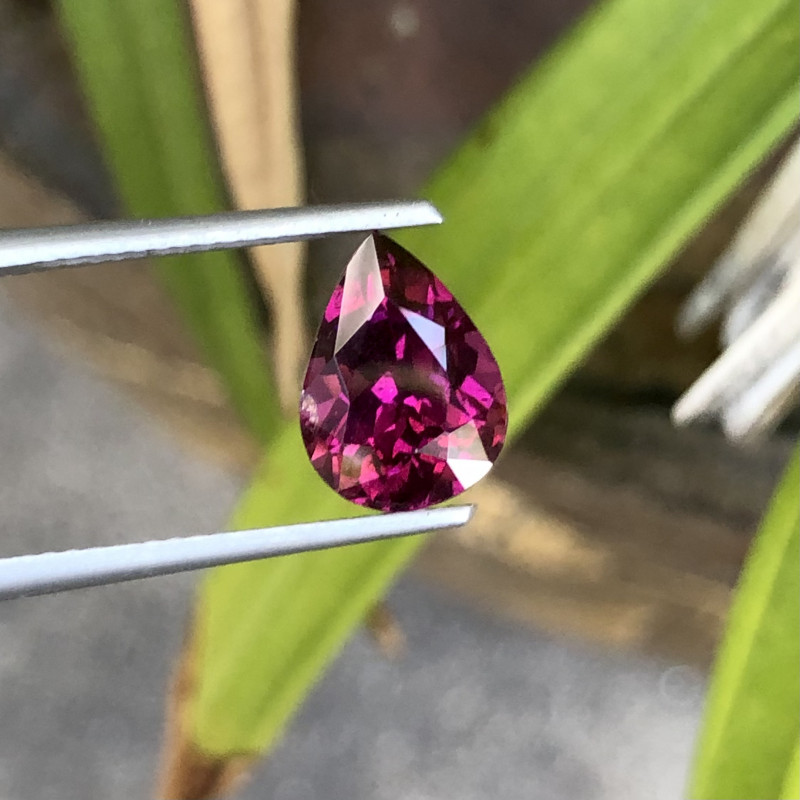 上の写真:洋ナシ形のファセット加工されたロードライトガーネット
上の写真:洋ナシ形のファセット加工されたロードライトガーネット
ロードライトの治癒特性
すべてのクリスタルと同様に、ロードライトはヒーリングストーンとして機能します。
レッドロードライトは、他の赤い宝石と同様に、力強さ、情熱、そして勇気を高めます。グレープガーネットのようなパープルロードライトは、他の紫色の宝石と同様に、精神的な知恵と自己認識を促進します。一方、ラズベリーロードライトのようなピンク色の石は、自分自身と他者への無条件の愛を促します。
身体の治癒
クリスタルヒーラーは、ロードライトを以下の治療に推奨しています。
心臓の問題
肺の問題
出血
股関節の問題
血行不良
感情的な癒し
感情面では、ロードライトはトラウマを経験した人に効果があります。罪悪感、ネガティブな記憶、そして自己不信から癒されると言われています。
恋愛関係にある人にとって、ロードライトは親密さを高め、ロマンスを盛り上げ、恨みや嫉妬を防ぐと信じられています。
チャクラヒーリング
ロードライトは、ルートチャクラ、ハートチャクラ、クラウンチャクラのチャクラストーンです。これら3つのチャクラを調和させることで、ロードライトはあなたに安定、感情的な気づき、そして精神的な高揚をもたらします。
 上の写真:ファセット加工された紫色のロードライトガーネット
上の写真:ファセット加工された紫色のロードライトガーネット
ロードライト宝石の特性
ロードライトの価値は、色、カット、透明度、そしてカラット重量によって決まります。また、処理や合成石についても解説します。
色
ロードライトガーネットの色はピンクから赤、紫まで様々で、その間のさまざまな色合いはアメジストやルビーに似ています。
ロードライトの赤は、他の暗すぎる赤色のガーネットに比べて、一般的に明るい色をしています。しかし、ラズベリー色や紫がかった赤の色彩でよく知られています。
グレープガーネットの場合、純粋な紫色の色合いは赤みがかった色合いよりも価値があります。
ロードライトの色に影響を与える可能性のある他の不純物としては、バナジウムとクロムがあります。スペサルタイトの含有量が多いと、色が薄くなることがあります。高温処理によっても色が変わることがありますが、これについては「処理」のセクションで詳しく説明します。
カット
ジュエリー市場で入手可能なロードライトのほとんどはファセットカットされており、その素晴らしい輝き(ブリリアント)を引き立てています。ラウンド、ペアシェイプ、オーバルシェイプが最も一般的ですが、StarBrite™カットや「ロードライト・ローズ」カットなど、様々なファンシーカットも見られます。
宝石職人はロードライトをカボションカットすることもあります。アステリズム効果を示す標本は、その効果を適切に表現するためにカボションカットする必要があります。ロードライトは彫刻やビーズにもカットされます。
 上の写真:アクセントダイヤモンド付きロードライトガーネットリング
上の写真:アクセントダイヤモンド付きロードライトガーネットリング
明瞭さ
ロードライトは一般的に非常に透明度が高く、 カラーストーンのクラリティグレードはタイプIIです。これは、肉眼で見える内包物がほとんどないか全くないことを意味します。拡大鏡で見ると、多くのロードライトに小さな結晶内包物が見られます。
具体的な内容としては次のようなものがあります:
いくつかの内包物は、スターロードライトのアステリズムの背後にあるルチル内包物の繊維状の束のように、光学的な効果を生み出します。
カラット重量
ロードライトは巨大なサイズのものもありますが、産地によって大きさは異なります。ノースカロライナ産のロードライトはわずか1~2カラットですが、アフリカ産のロードライトは75カラットを超えることもあります。
知られている最大のスターロードライトガーネットは、タンザニアのカンガラ鉱山産の15.6カラットのカボションカットです。ファセットカットされたロードライトの中でも最大級の宝石の一つは、同じくタンザニア産の86.4カラットのものです。
コストの面では、ファセットカットされたロードライトのカラット当たりの価格は、1カラット未満、1〜10カラット、10カラットを超えると高くなります。
治療
ロードライトが処理されることは稀ですが、実験は行われています。1997年には、加熱処理によってロードライトが赤褐色またはオレンジ色になり、金属的なコーティングが残るという実験が行われました。その後の実験では、ロードライトを600℃(1112°F)に加熱すると、紫色から茶色(ヘソナイトに似た色)へと不可逆的に変化することが示されました。
金属コーティング加工されたパイロープ・アルマンディン・ガーネットは、かつて「プロテウス・ガーネット」として販売されていました。反射光ではヘマタイトに似た暗い金属光沢を放ち、透過光では暗赤色に見えることから、形を変えるギリシャ神話の海神プロテウスにちなんで名付けられました。
合成品と模造品
合成ロードライトは、研究目的で熱水合成法によって製造されています。宝石市場に流通する場合もありますが、稀です。
見た目は似ているものの化学的性質が異なるロードライト類似石が「合成ロードライト」として販売されているのを見かけることがあります。
一般的なロードライト類似品は、キュービックジルコニアまたは色付きガラスです。
自然界に戻って、ロードライトはどのように形成されるのでしょうか?
 上の写真:ロードライトガーネットの原石
上の写真:ロードライトガーネットの原石
ロードライトの形成と起源
ロードライトは、ほとんどのガーネットと同様に形成されます。アルミニウム含有量の高い堆積岩は、熱と圧力によって変成作用を受け、内部の鉱物がロードライトのような新しい鉱物へと変化します。
アルマンディンガーネットは、雲母片岩のような変成岩やペグマタイトのような火成岩に産出します。パイロープガーネットも同様に、キンバーライトのような火成岩に産出します。
地理的に、ロードライトはどこで見つかりますか?
採掘場所
ロードライト宝石の原料を見つけるのに最適な産地は、ブラジル、インド、マダガスカル、スリランカ、タンザニア、ジンバブエです。
米国のノースカロライナ州は、比重と屈折率の測定値が特に高いロードライトの産地として有名ですが、現在では過去に比べてロードライトの産出量が大幅に減少しています。
宝石品質のロードライトのその他の重要な産地は以下のとおりです。
アフガニスタン
オーストリア
カナダ
中国
エチオピア
ケニア
モザンビーク
ミャンマー
ノルウェー
ロシア
アメリカ合衆国(アラスカ)
ウンバライト・ガーネットは、タンザニアのウンバ川渓谷で産出されます。タンザニアは、特に北パレ山脈で産出される、色が変化するロードライトの産地でもあります。
一方、スターロードライトガーネットの多くは東アフリカ(タンザニアを含む)から産出され、グレープガーネットのほとんどはブラジルとインドで産出されています。
出所はさておき、ロードライトって高価な石なんでしょうか?それについては次にお話ししましょう。
 上の写真:深紅のロードライトガーネットペンダントネックレス
上の写真:深紅のロードライトガーネットペンダントネックレス
ロードライトガーネットの価格と価値
ロードライトは高価ですが、ルビーや希少なガーネットに比べるとお手頃です。一般的に、ロードライトガーネットの1カラットあたりの価格は20ドルから300ドル程度です。
ファセットカットされたロードライトのカラット重量別の一般的な価格は次のとおりです。
0.5~1カラット:1カラットあたり20~100ドル
1~10カラット:1カラットあたり20~150ドル
10カラット以上:1カラットあたり40~300ドル
次に、カラット重量別のロードライト カボションの価格を示します。
0.5~1カラット:1カラットあたり4~6ドル
1~10カラット:1カラットあたり5~30ドル
10カラット以上:1カラットあたり5~40ドル
ロードライト原石の標本は最も安価で、卸売価格は 1 カラットあたり 0.70 ~ 8 ドルです。
ロードライトのお手入れとメンテナンス
ロードライトは耐久性に優れ、劈開性も低いため、宝石のお手入れは比較的簡単です。普段使いにも十分な耐久性を備えていますが、ロードライトガーネットのリングには保護セッティングが必要になる場合があります。
ただし、隠れた内包物にはリスクがあります。高温洗浄や超音波洗浄は、微細な内包物を破裂させる可能性があるため、機械洗浄は避けてください。
代わりに、柔らかい歯ブラシ、中性洗剤、ぬるま湯でロードライトを洗い、他の宝石とは分けて保管してください。
 上の写真:ファセットカットされた茶色がかった赤から赤紫色のロードライトガーネットが重ねられたシルバーブレスレット
上の写真:ファセットカットされた茶色がかった赤から赤紫色のロードライトガーネットが重ねられたシルバーブレスレット
ロードライトに魅了された?
ロードライトは、ガーネットの中でも最も人気のある宝石の一つです。耐久性、輝き、洗練された色合いを兼ね備え、しかも手頃な価格で提供されています。
手頃な価格のルビーの代替品をお探しの場合も、時代を超えたガーネットの変種をお探しの場合も、ロードライトは最適な選択です。
Gemstone Encyclopedia検索
最新記事
ヤシ象牙彫刻は、植物象牙とも呼ばれ、南米のヤシ科植物フィテレファス属のヤシの実から倫理的に採取された、象牙の天然代替品です。このガイドでヤシ象牙についてすべて学びましょう!
15th Jan 2026
レインボーラティスサンストーンは、様々な内包物によって3つのゴージャスな光学的効果を持つ長石の一種です。燃えるように鮮やかな色合いと格子模様が、コレクターにとって希少な宝石となっています。
12th Jan 2026
記事のカテゴリ
How To's is where you will find helpful articles from gem Rock Auctions on how to cut gemstones, select gemstones and buy gemstones.
9記事数



